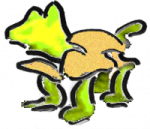translated from French by Jennifer Neal; read in french 👉here👈
Recently, I had to treat two teenagers presenting epistaxis on a daily basis without any causes being found. No clotting, no sinus issues.
Among many possible osteopathic causes, one that is quite common and obvious, is an overly high and poorly managed MTF (medullary traction force) during the child’s growth.
Recalling the case of Vega the little hydrocephalic cat, (Meningeal pathologies) who often let out a yellowish syrupy liquid when we successfully treated her MTF. The explanation that we can put forward is that the olfactory nerve, which is subject to the MTF and is also nested in the cribriform plate of the ethmoid, creates in the latter a tension/traction which can sometimes lead to a cerebrospinal fluid leakage. But it can be also added to chronic inflammation of the area, and sometimes blood can leak out, resulting in sporadic or regular epistaxis.
This pathology is encountered in line with MTF, in infants, young babies, and then in adolescence.
Case of a baby:
A young boy was diagnosed with overstretched MTF with difficulty to find his balance, at a very early stage and on a regular basis. When he was a baby, every time he would get upset, he would go into opisthotonos, a characteristic symptom for a baby. During seizures, he would regularly have nosebleeds.
The MTF and tensegrity body treatment would give him instant relief, but each time something would happen in his growth (height gain, tooth growth), he would block himself again, and we would have to intervene. Around the age of two it got stabilised. In the meantime, he had shown how, two days before he started walking, his hip’s torsion could be reversed. Then when he had to be vaccinated, he had a few days of fever and convulsions. The MTF treatment stopped the attack immediately, so it didn’t get worse, nor was it officially recorded as a consequence of the vaccine and its disruption of the immune system.
Now, every time he has a growth spurt, he blocks the MTF a little and a sensitivity to dust and pollen appears as a symptom (like in the family line) which can lead to asthmatic respiration, that calms down with punctual medication, but above all by lowering the MTF again. The nosebleeds didn’t reappear after the child was 2 years old.
Case of two young teenagers:
For several months now, they have experienced nosebleeds every day, multiple times a day. On the osteopathic menu, an overstretched MTF and a reversed physiological torsion. One of them also shows knee pain similar to Osgood Schlatter Syndrome. One treatment was enough to make the symptoms disappear. And unless there is a growth spurt or too much stress, the results should be permanent.
Case of another teenager:
M is sixteen years old, he has been suffering from his knee for several months, the doctors think it is a meniscus problem, but no exams have been able to confirm it so far. Listening to the anamnesis, one can only think of Osgood Schlatter, even though the symptoms described are not characteristic (rather internal pain, meniscus laxity). However, if one thinks of a high MTF, before doing any manual tests, one can wonder. Do you have epistaxis on a regular basis? The answer is “Yes but I’m not sure it’s linked”.
How about you? Do you think there is one?
Patrick Chêne,
Translate by Jennifer Neal




